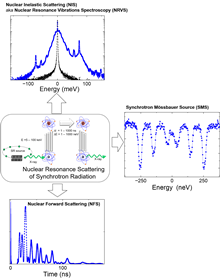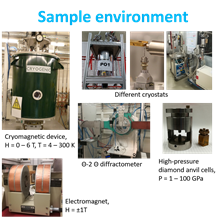Nuclear Resonance Scattering (NRS), based on the Mössbauer effect, combines the strengths of Mössbauer spectroscopy with the advanced capabilities of synchrotron radiation. At beamline P01, NRS user operation began in November 2011, and since then, the technique has been successfully applied across a wide range of scientific fields.
Several complementary NRS methods are available at the beamline:
- Nuclear Inelastic Scattering (NIS), also referred to as Nuclear Resonance Vibrations Spectroscopy (NRVS), enables measurement of the lattice dynamics (phonon density of states) in Mössbauer isotopes. It also provides insights into related thermodynamic properties.
- Nuclear Forward Scattering (NFS) is a time-domain analog of conventional Mössbauer spectroscopy. The technique exploits hyperfine interactions, producing time-domain interference patterns whose beat frequencies are inversely proportional to the hyperfine splitting. NFS allows detailed studies of electronic, magnetic, and dynamic properties of solids.
- 57Fe Synchrotron Mössbauer Source (SMS) provides a polarized, collimated and highly monochromatic X-ray beam for energy-domain 57Fe Mössbauer spectroscopy. Compared to traditional Mössbauer spectroscopy, SMS enables measurements on micrometer-scale samples or under grazing incidence geometry, taking full advantage of synchrotron source
Isotopes and instrumentation
The Mössbauer effect relies on specific nuclear transitions in isotopes of certain elements, where excited nuclear states enable recoil-free, resonant emission and absorption of radiation. Each isotope is characterized by its transition energy (5-100 keV) and excited-state lifetime (0.1 – 1000 ns).
Realizing NRS experiments for different isotopes demands custom X-ray optics, especially high-resolution monochromators (HRMs), and specialized detectors to accommodate the unique requirements of these isotopes.
Mössbauer isotopes studied at beamline P01
| Isotope | nat.(%) | E(keV) | tau0 | Methods | dE (meV) | focus (um) |
|---|---|---|---|---|---|---|
| 57Fe | 2 | 14.4 | 141 | NFS,NIS,SMS | 0.9 | 10 |
| 119Sn | 9 | 23.9 | 26 | NFS,NIS | 0.7 | 70 |
| 121Sb | 57 | 37.1 | 5.0 | NFS,NIS | 1.2 | 150 |
| 125Te | 7 | 35.5 | 2.1 | NFS,NIS | 1.2 | 150 |
| 193Ir | 63 | 73.0 | 9.1 | NFS | 150 | - |
| 169Tm | 100 | 8.4 | 5.8 | NFS,NIS | 1.7 | 10 |
Proposals involving the listed isotopes are welcome and regularly supported at beamline P01. If you are interested in exploring other Mössbauer isotopes, we encourage you to contact the beamline staff to discuss feasibility and experiment requirements.
Sample environment
The beamline offers a versatile sample environment to accommodate a wide range of user experiments. Available equipment includes various types of cryostats and furnaces, enabling a temperature range from 4 K to 550 K. High-pressure studies can be performed using diamond anvil cells (DACs) available at the beamline. For magnetic field applications, the beamline provides an electromagnet with a maximum field of 1 T and a cryogenically cooled vector magnet system capable of reaching temperatures as low as 4 K and magnetic fields up to 6 T.
The beamline is also equipped with polarizer–analyzer optics for polarization analysis of scattered radiation. Grazing incidence experiments can be performed using the theta–2theta diffractometer. A variety of motorized stages are available to facilitate the integration of complex user-supplied equipment when necessary.
Users are encouraged to contact the beamline staff in advance to discuss specific equipment requirements for their experiments.








